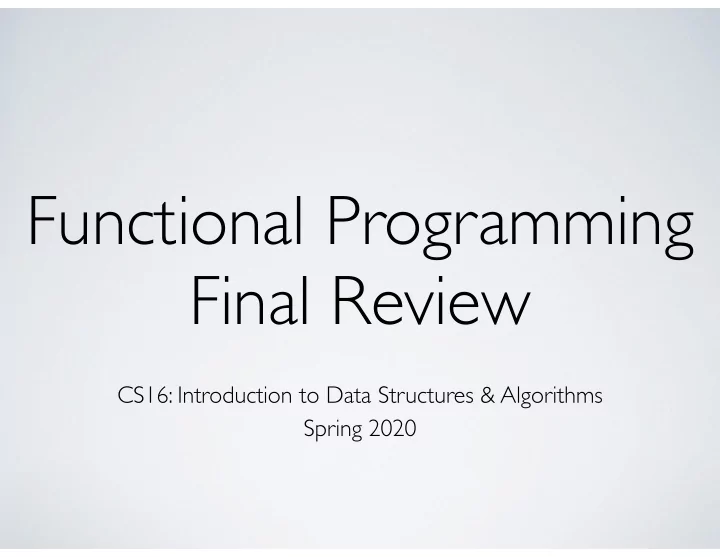

Functional Programming Final Review CS16: Introduction to Data Structures & Algorithms Spring 2020
Functional Programming Paradigm ‣ A style of building the structure and elements of computer programs that treats computation as the evaluation of mathematical functions . ‣ Programs written in this paradigm rely on smaller methods that do one part of a larger task. The results of these methods are combined using function compositions to accomplish the overall task. 2
Approaches ‣ How do we decide to use map vs. reduce? ‣ Map creates a one to one mapping - we use it for (sub)-problems that involve doing the same thing to multiple elements. ‣ Length will stay the same! ‣ Reduce can be used to “summarize” a list, or create a new (smaller or larger) list ‣ Map can be implemented with reduce, but not vice-versa! 3
Using Map ‣ How to choose the function? ‣ What do you want to have happen to each element in the input list? ‣ Other variables needed for the function can be created outside of the map call if needed! ‣ Quick Tip ‣ Built-ins/existing functions do not need to have their arguments written out. map(lambda x: f(x), input_list) => map(f, input_list) 4
Using Reduce 1/2 ‣ How to choose the binary function? ‣ Takes in the acc and each successive element in the input list. ‣ Think about how to break down your task! ‣ the max of an entire list -> the max of two integers ‣ remove all successive duplicates -> check if 2 elements are equal ‣ Remember ternary syntax! a if condition else b 5
Using Reduce 2/2 ‣ How to choose the accumulator? ‣ Needs to be of the type that you are returning ‣ What should your operation return on the empty list? 6
List Syntax ‣ [x] ‣ makes a list out of element x ‣ my_list[-1] ‣ returns the last element in my_list ‣ my_list + [x] ‣ returns a new list with x at the end, and does not modify the original list. ‣ don’t use append! this modifies the original list and returns nothing. 7
Practice Problems ‣ Write a function that will turn a list of nouns into adverbs. (ex: loud -> loudly) ‣ Write a function that sums the total length of a list of strings. (ex: [“hi”, “cs16”] -> 6) ‣ Write a function that counts the number of times the string “dog” appears in a list of strings. ‣ Write a function that removes numbers less than 10 from a list of ints. 8
Practice Problem Answers ‣ map(lambda el: el+”ly”, input_list) ‣ reduce(lambda acc, el: acc+el, map(len, input_list), 0) ‣ reduce(lambda acc, el: acc+1 if el == "dog" else acc, input_list, 0)) ‣ reduce(lambda acc, el: acc+[el] if el > 10 else acc, input_list, []) 9
Dynamic Programming Final Review CS16: Introduction to Data Structures & Algorithms Spring 2020
What is Dynamic Programming? ‣ Algorithm design paradigm/framework ‣ Design efficient algorithms for optimization problems ‣ Optimization problems ‣ “find the best solution to problem X ” ‣ “what is the shortest path between u and v in G ” ‣ “what is the minimum spanning tree in G ” ‣ Can also be used for non-optimization problems 11
When is Dynamic Programming Applicable? Condition #1 : sub-problems ‣ ‣ The problem can be solved recursively ‣ Can be solved by solving sub-problems Condition #2 : overlapping sub-problems ‣ ‣ Same sub-problems need to be solved many times 12
Sub-Problems Sol Sol Sol Sol Sol Sol Sol Sol Sol 13
Overlapping Sub-Problems Sol Sol Sol Sol Sol Sol Sol Sol Sol Why solve red twice? Why solve blue twice? 14 14
When is Dynamic Programming Applicable? Core idea ‣ Decompose problem into its sub-problems ‣ and if sub-problems are overlapping then ‣ ‣ solve each sub-problem once and store the solution ‣ use stored solution when you need to solve sub-problem again 15
Steps to Solving a Problem w/ DP ‣ What are the sub-problems ? ‣ What is the “ magic ” step? ‣ Given solution to a sub-problem… ‣ …how do I combine them to get solution to the problem? ‣ Which (topological) order on sub-problems can I use? ‣ so that solutions to sub-problems available before I need them ‣ Design iterative algorithm ‣ that solves sub-problems in order and stores their solution 16
Shortest Path in Layered Directed Graph a 5 10 b c 12 -3 6 5 ‣ Layered ‣ edge (x,y) only if x<y 2 d e ‣ Negative & positive weights 3 3 f
Recommend
More recommend